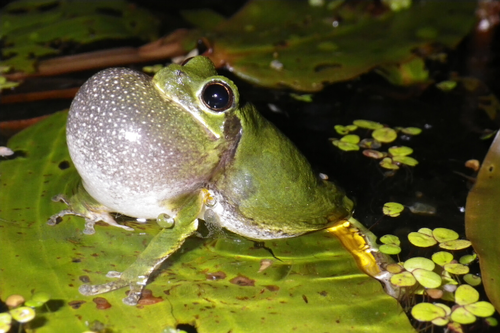
The cacophony of early spring sounds — especially near ponds — is hard to miss. One frequent contributor are Cope’s gray tree frogs. The males sing with the hope that a female decides to mate with them.
However, not all are equally adept at carrying a consistent tune.
“Female tree frogs estimate a male’s average call rate over a period of time. If there’s a lot of variation, they might be misled about what the average call rate is,” said Jessie Tanner, first author on a paper recently published in Science Advances and former Ph.D. student in Professor Mark Bee’s lab. Inconsistent calling complicates mate selection.
Calling is an important aspect of mate selection for many species of frogs. Producing frequent and long calls is difficult because it expends a significant amount of energy. In particular, females cue into call rate — or how often the frog produces a series of sound pulses — when selecting a mate. Males with attractive calls may give better genes to their offspring than males with less attractive calls.
“Inconsistent call rates amongst male Cope’s gray tree frogs make it harder for females to distinguish between good and bad potential mates,” said Mark Bee, professor in Ecology, Evolution, and Behavior and a co-author on the paper.
In past studies, researchers identified ambient noise in the background causing challenges with signal reception. Dubbed “the cocktail party problem,” it’s the same phenomenon that makes deciphering a single voice in a crowded, noisy room challenging.
To mimic the noisy breeding ponds, researchers studied mate choice in different noise conditions. In the best case, a female chose between two males in an otherwise quiet room. In the worst case, the female chose between two males amidst the loud chorus noise caused by many other frogs calling in the background.
Surprisingly, researchers found that the inconsistent signals had a greater impact than the chorus noise on a female frog’s ability to pick the “best” male. Until this study, the idea that inconsistent call rates influence female mate selection was largely overlooked.
The researchers also studied recordings of wild males’ calls, and found that males with the most attractive call rates tended to call most consistently. However, even unattractive males sometimes managed brief “sound bites” of attractive signals.
“We hypothesize that unattractive males leverage these ‘sound bites’ to deceive females and mate when they otherwise would not be chosen,” Tanner said. This is important, as it indicates that animal signals may evolve more slowly than previously thought.
When scanning the communication field more broadly, researchers noticed some parallels between animal behavior and other fields, like politics and advertising. “One universal idea in the communication field is that when the message changes frequently, it is difficult to discern the main idea,” said Tanner. “We showed that mixed messages led to poor decision-making.”
About the College of Biological Sciences
The College of Biological Sciences at the University of Minnesota is one of two colleges in the United States dedicated to the biological sciences with undergraduate majors and graduate programs that cover the spectrum of life from molecules to ecosystems. Learn more at cbs.umn.edu.
- Categories:
- Health




